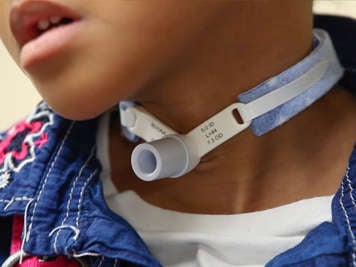
What is a tracheotomy?
A tracheotomy is a surgical procedure to create an opening into the trachea (windpipe). The opening, or stoma, is called a tracheostomy.
Why does my child need a tracheotomy?
There are many reasons why a child may need a tracheotomy. It can allow a child to:
- overcome an upper airway obstruction (blockage) or narrowing
- receive breathing support from a machine, such as a ventilator
- clear excess secretions (mucus) from their lungs.
What is a tracheostomy tube?
A tracheostomy tube (also known as a "trach tube") is the tube that is inserted into the stoma to help your child breathe and prevent the stoma from closing.
Your health-care team will tell you about your child’s condition and how long they will need a tracheostomy tube.
The team will also teach you how to suction and change your child's tracheostomy tube, clean your child's stoma, prepare for any travel with your child and respond quickly if there is an emergency.
How does a tracheostomy tube work?
When you breathe, you take in oxygen through your nose or mouth and it travels down the trachea into your lungs. The hairs in the nose help to filter particles and warm and humidify the air before it reaches the lungs.
When a tracheostomy tube is inserted, it becomes the main point for air to enter the respiratory system. In some children, a small amount of air may also be able to pass through the nose and mouth and go around the tracheostomy tube to get to the lungs.
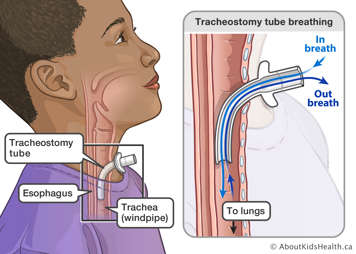
What are the different parts of a tracheostomy tube?
Tracheostomy tube
This is a curved hollow tube usually made of plastic or silicone that is inserted into the trachea. Sometimes metal tracheostomy tubes are used for very small children.
Tracheostomy tubes can have:
- two parts, consisting of an outer cannula and obturator
- three parts, consisting of an outer cannula, inner cannula and obturator.
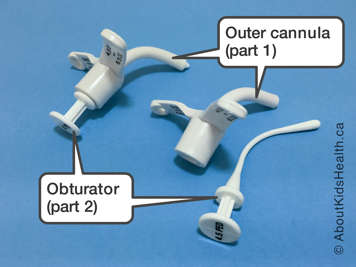
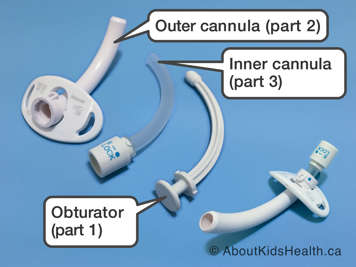
Tracheostomy tubes may also have:
- a cuff, which may be filled with water or air
- fenestrations (holes) to assist with speech.
Your health-care team has identified the ideal type of tracheostomy tube for your child.
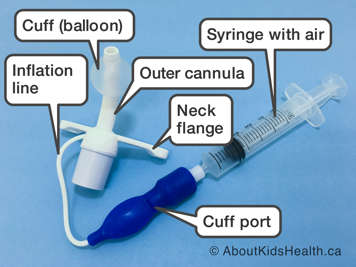
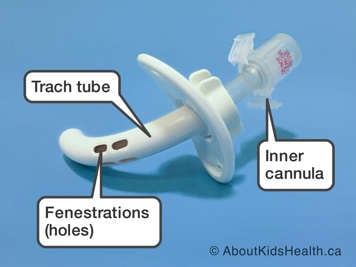
Outer cannula
This holds the tracheostomy open. The neck plate (flange) sits on the neck and has two holes for ties that will wrap around to the back of the child’s neck and hold the tracheostomy tube in place.
Inner cannula
The inner cannula fits inside the outer cannula and is locked into place so that it will not fall out when your child coughs. It must be removed routinely for cleaning. Inner cannulas usually only come with larger sized tracheostomy tubes.
Obturator
This is a piece of rigid plastic, silicone or metal that fits inside the outer cannula when a tracheostomy tube is being inserted. It helps guide the tracheostomy tube into place, causing less damage to the tissues. The obturator must be removed immediately once the tracheostomy tube is in the trachea so that the child can breathe through the tube.
Identifiers on tracheostomy tubes
You will see some letters and numbers on your child's tracheostomy tube. These will help you make sure you are using the right tube for your child.
- On the right flange (left side if you are looking at your child), is the brand of the tube, the size and the type.
- On the obturator, in the middle, is the size. The number is the diameter or thickness of the tube. It should be the same as the number on the right flange. The letters (NEO or PED) indicate the length of the tube.
- On the left flange (right side if you are looking at your child), is the inner diameter (ID) of the tube and, underneath, the outer diameter (OD). Both of these measurements are in millimetres.
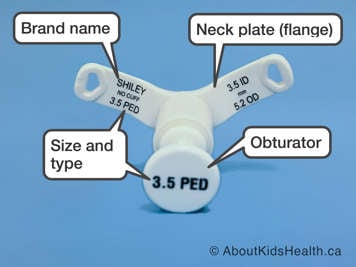
Trach tube ties
These are ties that attach to the flanges and pass around the neck to secure the tracheostomy tube in place. Ties are usually made of soft material that repels moisture and are held together by Velcro.
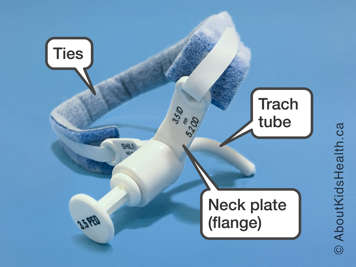
Heat and moisture exchanger (HME) (also known as a Swedish Nose)
This small device is attached to the tracheostomy tube to provide humidity (moisture) when your child is awake and active. It contains a small sponge that acts as a filter and is moistened when your child breathes. Much like the cilia (small hairs) in the nose, the HME removes irritating particles from the air that your child breathes in. Your health-care provider will tell you which HME is suitable for your child.
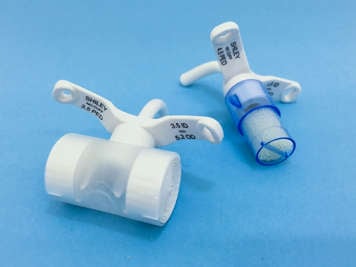
What should I expect when my child has a tracheostomy?
Mucus
Your child may produce more secretions in the first few months after a tracheotomy because they are no longer filtering air through their nose. The HME on the end of the tracheostomy tube can help reduce the amount of particles your child breathes in, which in turn reduces the amount of secretions. As time goes on, the secretions will decrease even when your child is not using a filter. Excessive foul-smelling secretions from the tracheostomy tube could indicate that there is an infection. If this happens, see your doctor.
Speaking
Your child may or may not be able to speak with the tracheostomy. Speaking requires air to pass around the tracheostomy and through the vocal cords. The amount of air that can pass around the tracheostomy tube depends on:
- how large the trachea is
- how much of the trachea is occupied by the tracheostomy tube
- how much scar tissue is above the tracheostomy tube
- how well your child’s vocal cords work.
An adjunct, or attachment, that helps with speaking is called a speaking valve (also known as a Passy-Muir Valve, or PMV). This is a one-way valve that allows air to pass upwards through the vocal cords. Your health-care provider will direct you how to use this if it is right for your child.
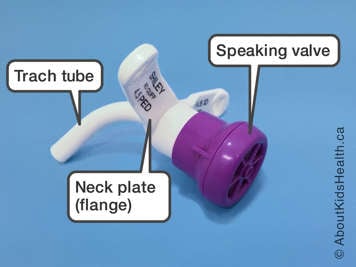
Eating
Depending on your child’s overall medical condition, they may still be able to eat with a tracheostomy tube in place. The trachea and esophagus (food pipe) both start in the back of the throat but are separate from each other.
However, your child might find it more difficult to swallow with a tracheostomy tube in place. This is because the voice box, which goes up and down with each swallow, gets slightly weighed down by the tube. Your child will get used to this and should be able to swallow after healing from the surgery.
Constipation
We push stool out of our bodies by taking a breath and forcing the air against closed vocal cords. In children with a tracheostomy tube, the air leaks out of the tube and does not allow the child to push. This can lead to constipation. You can help prevent constipation by giving your child lots of water, feeding your child higher-fibre foods and using stool softeners if required. Talk to your health-care provider if you have questions about constipation.
